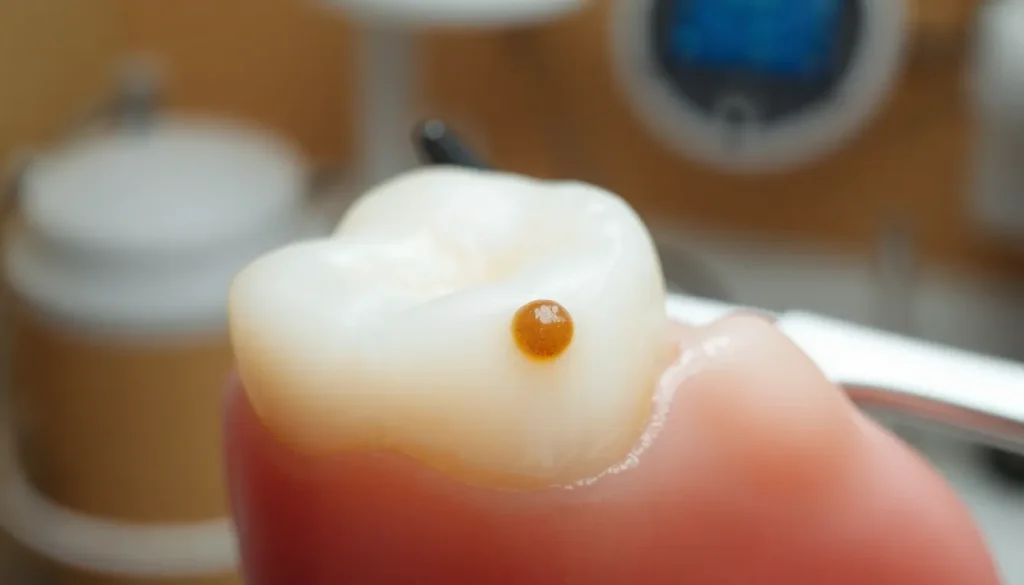Ever wondered what the smallest cavity actually is? When most people think of cavities, they picture obvious holes in teeth, but the tiniest dental cavities can be nearly invisible to the naked eye yet still cause important damage.
Detecting these microscopic trouble spots early can save you pain, money, and your natural tooth structure. Modern dentistry has revolutionized how we identify these miniature decay areas, using advanced imaging technology to spot cavities when they’re just beginning to form. You’ll be surprised to learn how these tiny imperfections develop and why catching them at their smallest stage is crucial for your long-term oral health.
Understanding Dental Cavities: The Basics
Dental cavities, also called dental caries or tooth decay, form when bacteria in your mouth create acids that erode tooth enamel. These tiny openings develop gradually, starting as microscopic lesions that aren’t visible to the naked eye. Bacteria naturally present in your mouth combine with food particles, especially sugars and starches, to form a sticky film called plaque that clings to teeth surfaces.
Acid production occurs when these bacteria digest sugars, with each acid attack lasting approximately 20 minutes after consuming sugary foods or drinks. Repeated acid attacks weaken the enamel’s mineral structure, eventually creating a small hole – the beginning of a cavity. Early-stage cavities appear as white spots on teeth, indicating areas where minerals have been lost from the enamel surface.
“I remember examining a patient who was diligent about brushing twice daily but rarely flossed,” shares Dr. Todd B. Harris. “Using our advanced imaging technology, I discovered multiple tiny interproximal cavities forming between her teeth – areas her toothbrush simply couldn’t reach. This case perfectly illustrates why detecting these smallest cavities early is so crucial.”
The progression of tooth decay follows five distinct stages:
- Initial demineralization – White spots appear as calcium and phosphate ions are lost
- Enamel decay – The outer tooth layer begins breaking down
- Dentin decay – Damage reaches the softer layer beneath enamel
- Pulp involvement – Infection reaches the tooth’s nerve center
- Abscess formation – Infection spreads beyond the tooth root
Cavity locations typically fall into three categories: pit and fissure cavities occurring on chewing surfaces, smooth surface cavities on flat areas of teeth, and root cavities forming below the gumline. Your risk factors for developing cavities include dietary habits, oral hygiene practices, fluoride exposure, dry mouth conditions, and genetic predisposition to tooth decay.
What Qualifies as the Smallest Cavity?

The smallest cavity represents the earliest stage of tooth decay, appearing as tiny brown to black discolorations on tooth surfaces. These minimal decay spots may be visible as subtle dark areas or chalky white spots, indicating initial enamel erosion has begun. Small cavities can develop on any tooth surface—top, bottom, or sides—and don’t always form an actual hole in the enamel yet.
Microcavities and Early Tooth Decay
Microcavities describe decay lesions so small they haven’t formed important holes but indicate weakening enamel. Dental professionals consider these lesions critically important because intervention at this stage prevents expansion into larger cavities requiring extensive treatment. These tiny decay areas share properties with larger cavities but differ dramatically in size and severity. Many patients miss these early warning signs since microcavities often remain virtually invisible without professional examination.
Dr. Todd B. Harris notes, “I’ve seen countless patients surprised when we identify microcavities during routine checkups. One patient, Sarah, came in for a regular cleaning with no symptoms whatsoever, yet our imaging revealed three microcavities between her molars. By catching these tiny spots of decay early, we saved her from potential root canals and crowns down the road.”
Detection Methods for Smallest Cavities
Finding the smallest cavities requires multiple diagnostic approaches working together. Visual examination involves looking for subtle discolorations, white spots, or small pits on tooth surfaces that indicate early decay. Dental probing utilizes a specialized pointed instrument to check for softened enamel areas that might not be visible to the naked eye.
X-ray imaging plays a crucial role in uncovering hidden cavities, particularly those developing between teeth or beneath the gumline where direct visual inspection can’t reach. Modern dental offices employ digital radiography that can detect density changes in enamel, revealing decay before it creates visible damage.
Early cavity detection provides important benefits for patients, including more conservative treatment options, reduced costs, and prevention of decay progression that might otherwise lead to painful toothaches or irreversible damage requiring extensive restorative work.
Why Small Cavities Matter: The Progression of Tooth Decay

Small cavities represent the earliest stage of tooth decay and serve as critical warning signs for your dental health. Understanding how these tiny imperfections progress can help you appreciate the importance of early intervention.
From Smallest Cavity to Major Dental Problems
The journey from a small cavity to severe dental damage follows a predictable path that dentists can identify and treat at various stages. Initial demineralization marks the beginning of tooth decay, appearing as white spots on your tooth surface where minerals have been stripped away by acid-producing bacteria in plaque. At this earliest stage, the damage remains reversible with proper oral hygiene practices and professional fluoride treatments.
Left untreated, these white spots darken to brown as the decay advances to enamel decay, creating actual holes in your tooth’s protective outer layer. Once these small cavities form, dental fillings become necessary to repair the damage and prevent further deterioration.
The situation becomes more serious when decay penetrates through the enamel into the dentin underneath. This softer tissue decays more rapidly and connects directly to your tooth’s nerve center, explaining why dentin decay typically causes increased sensitivity and pain. Decay that reaches the pulp—the nerve-rich center of your tooth—triggers severe pain, infection risk, and potential abscess formation, often necessitating root canal therapy or even extraction.
Dr. Todd B. Harris often shares the case of a patient who ignored what appeared to be a tiny dark spot on their molar. “By the time they came in with pain six months later, what started as a barely visible cavity had destroyed nearly half the tooth structure and required extensive restoration. Had we caught it at the microcavity stage, a simple filling would have solved the problem in minutes.”
The progression data shows clear patterns:
| Stage of Decay | Visible Signs | Treatment Options | Reversibility |
|---|---|---|---|
| Initial Demineralization | White spots | Fluoride treatment, improved hygiene | Fully reversible |
| Enamel Decay | Brown spots, small holes | Dental fillings | Irreversible, requires restoration |
| Dentin Decay | Larger cavities, sensitivity | Larger fillings, possible crowns | Irreversible, rapid progression |
| Pulp Involvement | Severe pain, infection | Root canal therapy | Irreversible, risk of tooth loss |
| Abscess Formation | Swelling, severe pain, pus | Root canal or extraction | Potential systemic health risks |
Treating cavities at their smallest stage preserves more natural tooth structure and costs significantly less than addressing advanced decay. Regular dental checkups with specialized imaging can detect these early warning signs before they develop into painful, expensive dental emergencies.
Treatment Options for Smallest Cavities

Early detection of small cavities opens up several conservative treatment options that preserve your natural tooth structure. These minimally invasive approaches focus on stopping decay progression before extensive damage occurs.
Minimally Invasive Dentistry Techniques
Minimally invasive dentistry prioritizes preservation of healthy tooth structure through gentle, targeted treatments. Air abrasion stands out as an effective technique that uses a stream of aluminum oxide particles to remove small amounts of decay without heat or vibration. This approach eliminates the need for anesthesia in many cases, making it particularly beneficial for children and anxious patients.
Advanced diagnostic tools play a crucial role in identifying cavities at their earliest stages. Dr. Todd B. Harris often tells patients, “The smallest cavities give us the greatest opportunity for conservative treatment. I recently treated a college student who was terrified of dental work but needed treatment for early decay between her molars. Using air abrasion instead of traditional drilling, we addressed the decay without anesthesia, and she was genuinely surprised when I told her we were finished.”
Preventative measures like dental sealants and antimicrobial agents create additional barriers against decay progression. These techniques complement regular home care and help maintain oral health without invasive procedures.
Remineralization Treatments
Fluoride treatments remain the cornerstone of remineralization therapy for the smallest cavities. Applied as varnishes, gels, or foams directly to affected areas, fluoride strengthens enamel and can actually reverse decay in its earliest stages. Research shows that professional fluoride treatments halt decay progression in approximately 80% of incipient lesions.
Silver Diamine Fluoride (SDF) offers a simple yet powerful option for treating small cavities. This FDA-approved liquid contains both silver (which kills bacteria) and fluoride (which promotes remineralization). A single application arrests decay in about 80% of cases, with success rates exceeding 90% after a second treatment. The only drawback is that treated areas turn black, indicating the decay has been stopped.
Resin infiltration provides another innovative solution for small cavities, especially those between teeth. This painless procedure involves cleaning the cavity area and applying a liquid resin that penetrates and seals the lesion without drilling or anesthesia. The entire process typically takes just 15-20 minutes and preserves substantially more natural tooth structure than traditional fillings.
Emerging biomimetic materials show promise for future cavity treatment. These advanced therapeutic agents aim to regenerate natural enamel, potentially eliminating the need for artificial fillings altogether. Though still in clinical development, these technologies represent the next frontier in minimally invasive dental care.
Preventing the Smallest Cavity Before It Forms

Early intervention stops microscopic cavities from developing into larger dental problems requiring extensive treatment. Preventive strategies focus on strengthening tooth enamel and reducing bacterial activity before demineralization progresses to visible decay.
Daily Oral Hygiene Practices
Effective oral hygiene serves as your first line of defense against the formation of even the smallest cavities. Brushing twice daily with fluoride toothpaste removes plaque and disrupts the acid-producing bacteria that initiate enamel demineralization. Fluoride plays a critical role in cavity prevention by strengthening enamel and promoting remineralization of weakened areas.
Regular flossing complements brushing by removing bacteria from spaces between teeth where toothbrush bristles can’t reach. Antimicrobial mouth rinses provide additional protection, especially for patients identified as high-risk through Caries Management by Risk Assessment (CAMBRA) evaluations.
Dr. Harris notes, “I’ve seen remarkable improvements in patients who commit to consistent oral hygiene routines. One patient with a history of frequent cavities maintained cavity-free checkups for three years after incorporating a prescription-strength fluoride rinse into their daily routine.”
Scheduled dental checkups every six months allow for professional cleaning and early detection of potential cavity sites. Professional applications of protective coatings like dental sealants create physical barriers against bacteria, particularly effective for molars with deep grooves. Silver diamine fluoride (SDF) treatments have emerged as powerful tools for arresting early decay, with studies showing they can stop cavity progression in up to 80% of cases.
Dietary Considerations
Your food choices significantly impact cavity development at its earliest stages. Sugary foods and beverages fuel acid-producing bacteria that attack tooth enamel, accelerating the demineralization process that leads to microcavities. Limiting sugar consumption reduces the frequency of acid attacks on your teeth.
Timing of food intake matters as much as content. Constant snacking throughout the day creates an environment where teeth experience continuous acid exposure without recovery time. Spacing meals allows your saliva to neutralize acids naturally and deliver minerals that repair microscopic damage to enamel.
Foods rich in calcium and phosphate support natural remineralization processes. Cheese, yogurt, nuts, and leafy greens contribute beneficial minerals that strengthen tooth structure. Drinking fluoridated water provides consistent, low-dose fluoride exposure that helps prevent the smallest cavities from forming.
“I recommend patients carry a refillable water bottle throughout the day,” says Dr. Harris. “One of my patients switched from sipping sodas to water and saw dramatic improvement in her oral health within months. The combination of reduced sugar exposure and increased hydration strengthened her enamel’s natural defenses against microcavities.”
Chewing sugar-free gum containing xylitol after meals stimulates saliva production, which washes away food particles and neutralizes acids. Xylitol also disrupts bacterial metabolism, reducing their ability to produce the acids that initiate cavity formation at the microscopic level.
When to See Your Dentist About Small Cavities

Early dental visits are crucial when you suspect a small cavity, even if you’re not experiencing any pain. Small cavities or microcavities—tiny holes smaller than a quarter—often go unnoticed in their initial stages but can quickly progress to more serious problems. Consulting your dentist at the first sign of tooth discoloration or sensitivity prevents the advancement of decay and potentially saves your natural tooth structure.
Your dentist should examine any suspicious areas during your regular checkups. These areas might appear as subtle dark spots or chalky white patches on your teeth. Professional intervention at this early stage can halt or even reverse the damage through conservative treatments like fluoride applications that strengthen your enamel.
Dr. Todd B. Harris often shares a story about a patient who ignored what seemed like a minor dark spot on a molar. “By the time the patient felt pain six months later, what could have been treated with a simple fluoride treatment required a full root canal procedure,” he explains. “Those few weeks of delay cost the patient important discomfort and expense.”
Don’t wait for pain to develop before seeking dental care. Pain typically indicates that decay has already progressed beyond the enamel and into the dentin or pulp of your tooth. At this advanced stage, more invasive treatments become necessary, including extensive fillings, crowns, or even root canals.
Regular dental appointments every six months allow for early detection of microcavities through professional examination and specialized imaging techniques. Your dentist employs tools like digital X-rays and laser fluorescence devices to identify decay that remains invisible to the naked eye.
Remember that small cavities represent the earliest stage of dental caries and require timely professional attention. Conservative management at this stage prevents progression to larger, painful cavities that demand more extensive treatment approaches.
Conclusion
Don’t wait for pain to signal trouble with your teeth. The smallest cavities may be nearly invisible but catching them early is your best defense against extensive damage and costly treatments.
Modern dental technology now makes it possible to detect microcavities before they progress into larger problems. Take advantage of these advancements by scheduling regular dental visits.
Remember that prevention is always easier than treatment. Maintain diligent oral hygiene routines use fluoride products and make smart dietary choices to protect your enamel from the earliest stages of decay.
Your smile deserves proactive care. With today’s minimally invasive treatments and early detection methods you can preserve your natural tooth structure and avoid the discomfort of advanced decay.
Frequently Asked Questions
What is a dental cavity?
A dental cavity (also called dental caries or tooth decay) forms when bacteria in your mouth produce acids that erode tooth enamel. This damage begins microscopically and gradually creates holes in teeth. Early cavities often appear as white spots before developing into more visible decay. Without treatment, cavities progress through five stages: demineralization, enamel decay, dentin decay, pulp involvement, and abscess formation.
What are microcavities?
Microcavities are the earliest stage of tooth decay, appearing as tiny brown to black discolorations or chalky white spots on tooth surfaces. These lesions haven’t yet formed actual holes but indicate weakening enamel. Dental professionals consider these early warning signs critical, as intervention at this stage can prevent larger cavities from developing, saving you from more extensive and expensive treatments later.
How are small cavities detected?
Small cavities are detected through several methods including visual examinations, dental probing, and advanced imaging technologies. Modern dentistry utilizes specialized tools like DIAGNOdent (laser fluorescence), digital X-rays, and intraoral cameras to identify decay that might be invisible to the naked eye. These technologies allow dentists to discover hidden decay between teeth or beneath the enamel surface before significant damage occurs.
Can small cavities be reversed?
Yes, the earliest stage of tooth decay (demineralization) can be reversed with proper intervention. Remineralization treatments, particularly professional fluoride applications and at-home fluoride products, can restore weakened enamel. Silver Diamine Fluoride (SDF) has proven effective in halting decay progression in about 80% of cases. Regular use of fluoride toothpaste and maintaining good oral hygiene also supports natural remineralization processes.
What treatment options exist for small cavities?
Small cavities can be treated with minimally invasive techniques like air abrasion (removal of decay without drilling), dental sealants (protective coatings), antimicrobial agents, fluoride treatments, and resin infiltration (sealing decay without drilling). These conservative approaches preserve more natural tooth structure compared to traditional fillings. New biomimetic materials that mimic natural tooth components are also emerging as treatment options for early decay.
How can I prevent microcavities from forming?
Prevent microcavities by brushing twice daily with fluoride toothpaste, flossing daily, limiting sugary foods and beverages, spacing out meals and snacks, drinking plenty of water (especially fluoridated water), consuming calcium-rich foods, and chewing sugar-free gum with xylitol after meals. Additionally, regular dental checkups every six months enable early detection and professional preventive treatments like dental sealants and professional fluoride applications.
When should I see a dentist about a possible cavity?
See a dentist at the first sign of tooth discoloration, sensitivity to hot/cold/sweet foods, or any unusual feeling in your teeth—even without pain. Don’t wait for pain, as it typically indicates advanced decay. Regular six-month checkups allow dentists to use specialized tools to detect microcavities before they become problematic. Early intervention means simpler, less expensive treatments and preservation of more natural tooth structure.
Why is early detection of cavities so important?
Early detection of cavities allows for more conservative treatment options, significantly reduces treatment costs, and preserves more natural tooth structure. Small cavities caught early can often be treated with minimally invasive techniques or even reversed through remineralization. If left untreated, decay follows a predictable path from tiny lesions to severe damage requiring root canals or extractions, causing pain and increasing expenses dramatically.







